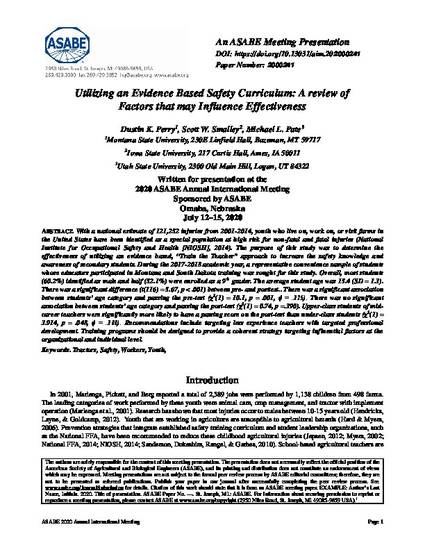
With a national estimate of 121,252 injuries from 2001-2014, youth who live on, work on, or visit farms in the United States have been identified as a special population at high risk for non-fatal and fatal injuries (National Institute for Occupational Safety and Health [NIOSH], 2014). The purpose of this study was to determine the effectiveness of utilizing an evidence based, “Train the Teacher” approach to increase the safety knowledge and awareness of secondary students. During the 2017-2018 academic year, a representative convenience sample of students whose educators participated in Montana and South Dakota training was sought for this study. Overall, most students (60.2%) identified as male and half (52.1%) were enrolled as a 9th grader. The average student age was 15.4 (SD = 1.3). There was a significant difference (t(116) = 5.67, p < .001) between pre- and posttest.. There was a significant association between students‘ age category and passing the pre-test (χ2(1) = 10.1, p = .001, ϕ = .315). There was no significant association between students‘ age category and passing the post-test (χ2(1) = 0.74, p =.390). Upper-class students of mid-career teachers were significantly more likely to have a passing score on the post-test than under-class students (χ2(1) = 3.914, p = .048, ϕ = .388). Recommendations include targeting less experience teachers with targeted professional development. Training programs should be designed to provide a coherent strategy targeting influential factors at the organizational and individual level.
Available at: http://works.bepress.com/scott-smalley/23/

This meeting paper is from Perry, Dustin K., Scott W. Smalley, and Michael L. Pate. "Utilizing an Evidence Based Safety Curriculum: A review of Factors that may Influence Effectiveness." 2020 ASABE Annual International Virtual Meeting, American Society of Agricultural and Biological Engineers, 2020. doi: 10.13031/aim.202000241. Posted with permission.